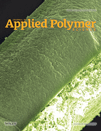Processing and characterization of injection moldable polymer–particle composites applicable in brazing processes
Abstract
A novel method has been developed to process highly filled polymer–particle composites to test samples as braze metal preforms. Polypropylene (PP), low-density polyethylene (LD-PE) and high-density polyethylene (HD-PE) were used as polymer matrices. Two types of nickel-based braze metal microparticles (Ni 102 and EXP 152) were compounded to the polymer matrices at filler contents up to 65 vol %. With enhancing filler content, torque at kneading rotors, and injection molding parameter were significantly affected by increasing viscosity. Injection molded composites show well-distributed spherical microparticles and particle–particle interactions. Polymers decompose residue-free at temperatures above 550°C, even for their composites. Adding particles reduces polymer crystallinity, whereas defined cooling at 5°C/min significantly increases the crystallinity and melt peak temperature of polymers compared to undefined cooling prior injection molding. Storage modulus of polymers increases significantly by adding filler particles. LD-PE + 65 vol % EXP 152 show the most suitable composite performance. © 2012 Wiley Periodicals, Inc. J. Appl. Polym. Sci., 2013




